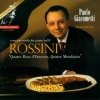
Rossini: Complete Works for Piano Vol.8
Rossini was a musical genious, a bon vivant, and last but not least, a true gourmet. And so I thought that it would be a good idea to give the eighth and last CD in this series a pronounced culinary atmosphere. We open with Quatre Hors d'Oeuvres (Four appetizers), four musical odes devoted in succession to Les Radis (Radishes), Les Anchois (Anchovies), Les Cornichons (Pickles) and Le Beurre (Butter). Then we abandon the table and proceed to the Prlude for piano solo from Musique Anodine (Blameless Music). Musique Anodine consists of the Prlude and the six following songs for voice and piano. The group is dedicated to Rossini's wife in thanks for her support after a long illness. Anodine, in this case, could also be understood as 'soothing'. Then come some calisthenics for singers in the form of Ritournelle Gothique (Gothic Refrain) Encore un peu de Blague (A little more Silliness), and Tourniquet sur la Gamme Chromatique, Ascendante et Descendante (Chromatic Merry-go-round, Rising and Falling). Rossini, in fact, dedicated this last piece to his friend Auguste Panseron, composer and singing teacher at the Paris Conservatory. After this harmonic exercise, we celebrate enthusiastically in Une Rjouissance (a Party), we take a gondola ride in Canzonetta: la Venitienne (Venetian song), and take a walk through all the different keys in (the environs of) Paris in Petite Promenade de Passy Courbevoie (A little walk from Passy to Courbevoie). At last we go back to the table to be served a dessert consisting of Quatre Mendiants (Four Mendicant Orders). This somewhat austere dessert, still served nowadays, consists of four ingredients, each of which represents a religious order because of its color which is like that of the respective order's habit. Les Figues Sches (dried Figs) represent the Franciscans, Les Amandes (the Almonds) the Carmelites, Les Raisins (the Raisins) the Dominicans, and Les Noisettes (the Hazelnuts) the Augustines. In addition, a genuine French military song is featured in Les Raisins. Nevertheless, Rossini dedicated it to his little parakeet. Les Noisettes is dedicated to his beloved little dog Nini. Review by James Manheim: After many decades when the public took Rossini's deprecating attitude toward his late piano works at face value, they have exploded in popularity, with various new individual recordings and several full cycles on the market. The sly, arcane humor of many of these works is susceptible to several entirely distinct interpretations, but one could do worse than stick with the fine cycle by Italian-Dutch pianist Paolo Giacometti. He performs on an 1858 Pleyel instrument close to the one Rossini would have known, and in the razzle-dazzle climaxes such as that of La réjouissance, track 11, where Rossini drops the comedy for sheer excitement (they're really not far from the big finishes of his earlier opera arias) that piano has just the right sound -- close to a modern grand but without the booming resonance. Elsewhere Giacometti strikes just the right intimate note in music that was intended for listeners who could follow its little jokes. This is the final disc in Giacometti's series. The food theme illustrated on the cover is rather loosely based on the opening Quatre Hors d'Oeuvres and on the concluding Quatre Mendiants (Four Mendicants), in which four mendicant orders -- Franciscans, Carmelites, Dominicans, and Augustines -- are color-coded by habit and assigned an appropriate food. That sounds a bit involved for casual comprehension, and in general Rossini's titles are fanciful rather than synaesthetic. Do the opening "hors d'oeuvres" resemble the foods they depict? Perhaps there's something buttery about the smoothly sensual opening music of "Le beurre" (track 4), but the music moves into energetic variations that are hard to connect with the subject. In other places, though, the link between these works and the music and attitude of Satie seems to close to coincidental. The Ritournelle Gothique (track 6) needs only a slightly less definitive focus on a tonic center to be brought into the realm of Satie's neo-medieval pieces. Two works that are in the nature of chromatic experiments, Tourniquet sure la gamme chromatique, ascendante et descendante and Encore un peu de blague (the latter title translates as a little more silliness), are nicely related to the rest of the music in Giacometti's interpretation; the humor of most of the music, which subverts its own simple forms with mischievous little harmonic twists, is rooted in the kind of exploration of the corners of the tonal system that is carried out a bit more systematically in these two pieces, and Giacometti finds a light touch that works throughout. Strongly recommended, despite the unidentifiable and unappetizing black mass of food on the plate on the cover.


